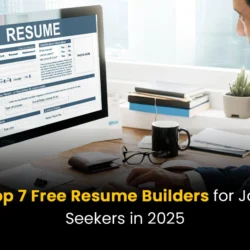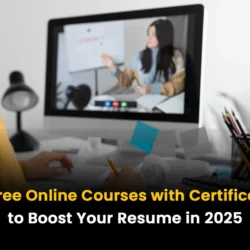Choosing the right career is the biggest decision of life for everyone. It affects not only your income but also your happiness, work-life balance, and future growth.
Whether you are a student who is confused about your future, a fresher who is looking for direction, or a professional who is thinking of changing your career, this guide is for you.
Let us understand this in some easy steps so that you can take your career decision with clarity and confidence.
Step 1: Understand What a Career Path Means
A career path is a journey that you take over time in different jobs, roles, and industries. It can either be linear (in one direction) or dynamic (changing fields). Such as:
- A linear path: Junior Developer → Senior Developer → Team Lead → CTO
- A dynamic path: Content Writer → Digital Marketer → Product Manager
Your path can evolve with time, but starting in the right direction helps avoid frustration later.
Step 2: Know Yourself – Interests, Skills, and Values
You can’t choose the right path unless you know:
- What you enjoy (interest)
- What you’re good at (skill)
- What matters to you (value)
How to Discover These:
- Take free online tests like the MBTI, Holland Code, or StrengthsFinder
- Ask yourself:
- What subjects or activities do I enjoy the most?
- What kind of work would I do even if I don’t get paid?
- Do I like helping people, working with machines, analysing data, or managing people?
Make a list of your top 3 interests, skills, and values. This will help narrow down options.
Step 3: Explore Career Options Based on Your Profile
Once you understand your preferences, start matching them with real-world careers.
| Interest Type | Suggested Career Options |
| Creative | Graphic Designer, Copywriter, UI/UX Designer |
| Analytical | Data Analyst, Accountant, Researcher |
| Social/Helping | Teacher, Counsellor, HR Professional |
| Technical | Software Developer, Engineer, IT Admin |
| Business-minded | Marketer, Sales Executive, Business Analyst |
You can search on platforms like:
- MyNextMove.org (for US-based career exploration)
- India’s NCS Portal
- LinkedIn Career Explorer
Step 4: Research Each Career Deeply
Don’t just go by the name of the job. Dig deeper:
What to Research:
- Day-to-day work (What tasks are common?)
- Salary expectations (Entry, mid, and senior levels)
- Job demand (Is it growing or shrinking?)
- Required skills and qualifications
- Work environment (Remote, office, fieldwork?)
Use YouTube, blogs, and career websites to watch interviews and read personal stories.
Step 5: Match with Your Education or Upskill Accordingly
Students:
- Choose a college course that fits your career interest (e.g., BBA for business roles, BSc for research)
- Start internships early to test your interest.
Professionals or Jobseekers:
- Identify skills you’re missing and learn them through:
- Online platforms like Coursera, Udemy, and Skillshare
- Government portals like NPTEL (India), SWAYAM
- Local certification programs
Even a short course or certificate can change your direction and open new doors.
Step 6: Experiment Before You Commit
Before you lock yourself into a 5-year plan:
Try These:
- Freelance projects
- Online internships
- Volunteer work
- Side gigs (like content writing, tutoring, digital marketing)
These mini-experiences help you test the field before diving in full-time.
You’ll also gain confidence and things to add to your portfolio/resume.
Step 7: Talk to People in the Industry (Career Networking)
Talking to real professionals gives you insights you won’t find on Google.
How to Network:
- Connect with alumni from your school or college
- Use LinkedIn to message professionals politely.
- Join webinars, meetups, and Discord groups.
- Ask questions like:
- How did you get into this field?
- What’s the best and worst part of your job?
- What skills helped you grow?
This will also help you discover hidden opportunities.
Step 8: Stay Flexible – Career Is a Journey, Not a Destination
It’s okay to change your mind later. Your career path can evolve with:
- New skills
- Market changes
- Personal priorities (like health or family)
Even switching fields is possible today with upskilling and experience.
So don’t panic. Choose what feels right now and be open to adjustments later.
Bonus Tips
- Don’t Choose Based on Just Money
Yes, money matters. But choosing a field only for salary can lead to burnout. Find a balance between passion, skill, and income. - Avoid Peer Pressure
Just because your friend chose an MBA doesn’t mean you should too. Your journey is unique. - Set Short-Term Goals
Instead of planning the next 20 years, focus on the next 6 months or 1 year.
Career Path Examples (By Field)
| Field | Career Path Example |
| Engineering | Intern → Junior Engineer → Project Lead → CTO |
| Writing & Media | Blogger → Content Writer → Editor → Content Head |
| Teaching | Assistant Teacher → Lecturer → Professor → Dean |
| Management | Sales Rep → Manager → Regional Head → VP |
| Tech/IT | Coder → Developer → Product Manager → Tech Lead |
| Design | Junior Designer → UI/UX Specialist → Design Lead |
Final Thoughts
Choosing the right career is not a matter of perfection, but of progress. There is no “one best career” – there is only the career that is best for you.
Start with what you know today, take action, learn, and adapt.
Remember: The earlier you start exploring, the clearer your path will become.













